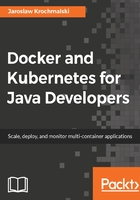
What this book covers
Chapter 1, Introduction to Docker, introduces the reasoning behind Docker and presents the differences between Docker and traditional virtualization. The chapter also explains basic Docker concepts, such as images, containers, and Dockerfiles.
Chapter 2, Networking and Persistent Storage, explains how networking and persistent storage work in Docker containers.
Chapter 3, Working with Microservices, presents an overview of what microservices are and explains their advantages in comparison to monolithic architectures.
Chapter 4, Creating Java Microservices, explores a recipe for quickly constructing Java microservice, by utilizing either Java EE7 or the Spring Boot.
Chapter 5, Creating Images with Java Applications, teaches how to package the Java microservices into Docker images, either manually or from the Maven build file.
Chapter 6, Running Containers with Java Applications, shows how to run a containerized Java application using Docker.
Chapter 7, Introduction to Kubernetes, introduces the core concepts of Kubernetes, such as Pods, nodes, services, and deployments.
Chapter 8, Using Kubernetes with Java, shows how to deploy Java microservices, packaged as a Docker image, on the local Kubernetes cluster.
Chapter 9, Working with Kubernetes API, shows how the Kubernetes API can be used to automate the creation of Kubernetes objects such as services or deployments. This chapter gives examples of how to use the API to get information about the cluster's state.
Chapter 10, Deploying Java on Kubernetes in the Cloud, shows the reader how to configure Amazon AWS EC2 instances to make them suitable to run a Kubernetes cluster. This chapter also gives precise instructions on how to create a Kubernetes cluster on the Amazon AWS cloud.
Chapter 11, More Resources, explores how Java and Kubernetes point the reader to additional resources available on the internet that are of high quality, to further extend knowledge about Docker and Kubernetes.